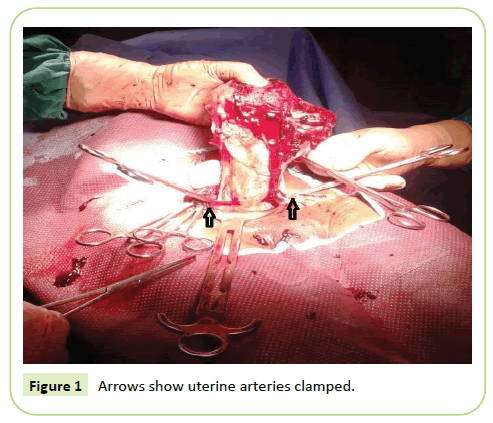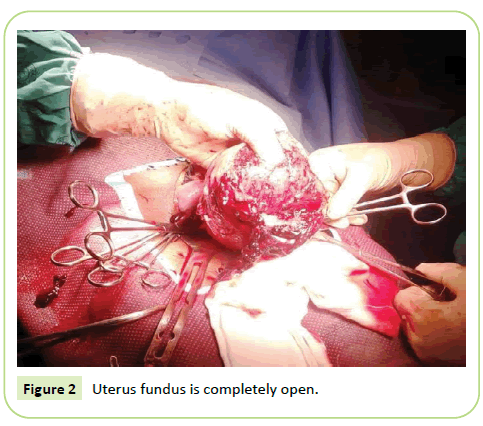Vizcaino LT1* and Herrera DC2
1Department of Obstetrics and Gynecology, Mofumahadi Manapo Mopeli Regional Hospital, South Africa
2Department of Pediatrics, Mofumahadi Manapo Mopeli Regional Hospital, South Africa
- Corresponding Author:
- Vizcaino LT
Consultant, Department of Obstetrics and Gynecology
Mofumahadi Manapo Mopeli Regional Hospital
Phuthaditjhaba
Free State, South Africa
Tel: 071-5261738
E-mail: leandro.torriente@yahoo.com
Received Date: March 18, 2020; Accepted Date: April 23, 2020; Published Date: April 30, 2020
Citation: Vizcaino LT, Herrera DC (2020) A Case Report of Spontaneous Rupture in Unscarred Uterus. Gynecol Obstet Case Rep Vol.6 No.2:13. doi:10.36648/2471-8165.6.2.93
Background: Uterine rupture is a life-threatening obstetrical complication whose
incidence has been increasing.
Case presentation: A 27-year-old patient, gravida two, para one, at 39 weeks 3
days referred from a District Hospital severely ill, Glasgow Coma Scale 10/15, BP:
70/42, Pulse: 134, Sat: 85% on room air and HB: 3,2 g/dl. Sonar DID: Free fluid in
abdominal cavity, uterine rupture, fetus out of the uterine cavity, no fetal heart
activity seen. The patient was transferred to the theatre, delivered stillborn male
baby, weight: 3221 g. There is a fundal uterine rupture that was extended until
both uterine horns, Total Abdominal Hysterectomy by Richardson Technique was
performed and was discharged seven days later.
Conclusion: Spontaneous uterine rupture is rare in the unscarred uterus. However,
can happen any time and in any trimester.
Keywords
Abruption; Uterine rupture; Unscarred uterus; Hysterectomy;
Trimester
Introduction
Uterine rupture is a life-threatening obstetrical complication
which incidence has been increasing. This condition usually
occurs in the setting of the trial of labor after cesarean delivery,
in patients with a history of trauma in the third trimester and few
reports have described its occurrence in early pregnancy. This
rare complication has an incidence of <1% in women with scarred
uteri, however, it is extremely rare in the unscarred uterus with a
suggested incidence of only 0.006% [1,2].
Case Report
This case is about a 27-year-old patient, gravida two, para one,
at 39 weeks, 3 days with no comorbidities. Have frequent visits
at Primary Health Care, Normal booking blood: HIV and Syphilis
negative, positive Rh. She was referred from a District Hospital
with a diagnosis of Placenta Abruption and Intrauterine Fetal
Death (IUFD) [3]. On admission, maternity record did not show
any evidence of hypertension during pregnancy. According to the
relatives, there is no history of trauma, accidents etc.
On physical examination patient was semi-conscious, severely ill,
with Glasgow Coma Scale of 10/15, BP: 70/42, Pulse: 134, O2 Sat:
85% on room air and HB of 3.2 g/dl. Abdomen on palpation SFH
at 38 cm, very tender and fetal parts easily palpable.
Sonar DID: Free fluid in the abdominal cavity, uterine rupture,
fetus out of the uterine cavity, no fetal heart activity seen.
With this diagnosis, the patient was transferred to theatre for
an emergency cesarean section. The patient underwent general
anaesthesia, Pfannenstiel incision performed, hemoperitoneum
about 3 L of blood, delivered stillborn male baby, weight: 3221
g. There is a fundal uterine rupture that was prolonged until
both uterine horns (Figures 1 and 2) also active bleeding noted,
so Total Abdominal Hysterectomy by Richardson Technique was
performed.
Figure 1: Arrows show uterine arteries clamped.
Figure 2: Uterus fundus is completely open.
The patient was transferred to ICU for hemodynamic control and
monitoring. Received blood, plasma and others medication for
three days, after that was transfer to PNC and was discharged
four days later in stable condition with BP: 132/81, pulse 78, O2
Sat: 98%, HB of 11.4 g/dl.
Discussion
Uterine rupture consists of an obstetrical emergency that is becoming more frequent in developed countries, perhaps
because of increasing cesarean section rates 3. Although the majority of cases occur in late gestation, mainly during TOLAC,
very few reports have described its occurrence in the first and
second trimesters of pregnancy, whether in scarred but also
(rarely) in unscarred uteri [4,5].
Spontaneous uterine rupture in the second trimester of pregnancy
without prior uterine surgery or trauma is rare. Reported cases
in the literature suggest underlying etiologies of abnormal
placental implantation, congenital uterine abnormalities such
as the bicornuate uterus and uterine septum. Occasionally, no
underlying cause is found [6-8].
In this particular case, no risk factors were found, same results
found Sun et al. [9] in one case report published in 2012. There are
many causes of abdominal pains who was the principal symptom
reported by the patient. We can divide in obstetrics and none/
obstetrics causes, like gastritis, peptic ulcer, appendicitis or
urinary tract infection [10]. Antepartum hemorrhage is caused by
different etiologies such as Placenta Previa, Placenta Abruption,
Uterine Rupture, and Vasa Previa with or without velamentous
umbilical cord insertion. That is why sonar plays an important
role in the early diagnosis and management [11]. Must be
performed it is possible by experimented personnel because in
the third trimester is more difficult found the myometrial defect.
Also is recommended when the patient is stable.
The management of uterine rupture depends first of all of the
clinical findings, localization, extension, parity, the expertise of
the surgeon and mother condition. When the defect is small, the
uterus can be either repaired or hysterectomy can be done [12],
like in this case.
Conclusion
Spontaneous uterine rupture is rare in the unscarred uterus.
However, it can happen any time and in any trimester, the quick
diagnosis and management can save both the mother and fetal
life.
Conflict of Interest
The authors declare that they have no conflict of interests.
References
- Miller DA, Goodwin TM, Gherman RB, Paul RH (1997) Intrapartum rupture of the unscarred uterus. Obstet Gynecol 89: 671-673.
- Hofmeyr GJ, Say L, Gulmezoglu AM (2005) WHO systematic review of maternal mortality and morbidity: The prevalence of uterine rupture. BJOG 112 (9): 1221-1228.
- Miranda A, Castro L, Rocha MJ, Cardoso L, Reis I (2017) Uterine rupture in early pregnancy. Int J Pregn & Chi Birth 2 (6): 00046.
- Tola EN (2014) First Trimester Spontaneous Uterine Rupture in a Young Woman with Uterine Anomaly. Case Rep Obstet Gyne 9: 673-686.
- Ijaz S, Mahendru A, Sanderson D (2011) Spontaneous uterine rupture during the 1st trimester: A rare but life-threatening emergency. J Obstet Gynae 31 (8): 772.
- Peirzynski P, Laudanski P, Lemancewicz A, Sulkowski S, Laudanski T (2012) Spontaneous rupture of unscarred uterus in the early second trimester: A case report of placenta. Gineko Pol 83 (8): 626-629.
- Agu PU, Okaro JM, Mbagwu UK, Obi SN, Ugwu EO (2012) Spontaneous rupture of gravid horn of bicornuate uterus at mid trimester-A case report. Niger J Med 21 (1): 106-107.
- Damiani GR, Gaetani M, Landi S, Lacerenza L, Barnabe M, et al. (2013) Uterine rupture in a nulliparous woman with septate uterus in the second trimester of pregnancy and review in literature. Int J Surg Case Rep 4 (3): 259-261.
- Sun HD, Su WH, Chang WH, Wen L, Huang BS, et al. (2012) Rupture of a pregnant unscarred uterus in an early secondary trimester: A case report and brief review. J Obstet Gynaecol Res 38 (2): 442-445.
- Ho WY, Wang C, Hong SC, Han HC (2017) Spontaneous uterine rupture in the second trimester: A case report. Obstet Gynecol Int J 6 (4): 00211.
- Vaknin Z, Maymon R, Mendlovic S, Barel O, Herman A, et al. (2008) Clinical, sonographic and epidemiologic features of second and early third-trimester spontaneous antepartum uterine rupture: A cohort study. Prenat Diagn 28 (6): 478-484.
- Sreelatha S (2018) A rare case of uterine rupture in an unscarred uterus. Gynae Perinat 2 (3): 281-284.



